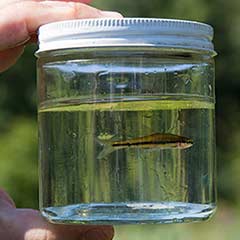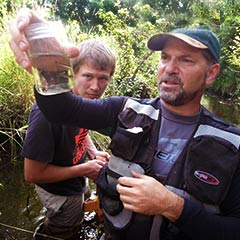 The bridle shiner, Notropis bifrenatus, is a tiny minnow species that was once among the most common fish species in clean streams and ponds in the New England coastal plain. Bridle shiners are short-lived fish with notably large eyes. They swim in small schools in clear water, where they can see and capture the small invertebrates that make up their prey. These fish depend on healthy, lush patches of underwater plants, into which they can quickly dart for cover when threatened by larger fish.
The bridle shiner, Notropis bifrenatus, is a tiny minnow species that was once among the most common fish species in clean streams and ponds in the New England coastal plain. Bridle shiners are short-lived fish with notably large eyes. They swim in small schools in clear water, where they can see and capture the small invertebrates that make up their prey. These fish depend on healthy, lush patches of underwater plants, into which they can quickly dart for cover when threatened by larger fish.
Today, bridle shiners have become rare throughout most of their range, which extends from South Carolina north to parts of eastern Ontario and Quebec. This species is listed as a rare species in nearly all states and provinces where it occurs. Bridle shiners have apparently declined sharply in many parts of their former range, and the species is now thought to be extirpated from Maryland and North Carolina. In Massachusetts, bridle shiners appear to be generally rare and spottily distributed in most of the state, particularly in the northeastern counties.
The Threat to Bridle Shiners
 Bridle shiners occupy one of the most intensively urbanized parts of the world - the mid-Atlantic and northeastern coastal plain of the United States. The streams and ponds that they once inhabited have been channelized and polluted, destroying the vegetation that the fish depend upon and ruining the water clarity they need to find their prey.
Bridle shiners occupy one of the most intensively urbanized parts of the world - the mid-Atlantic and northeastern coastal plain of the United States. The streams and ponds that they once inhabited have been channelized and polluted, destroying the vegetation that the fish depend upon and ruining the water clarity they need to find their prey.
Introduced Eurasian mifoil (Myriophyllum spicatum), an invasive aquatic plant, has displaced the native submergent plants that this small fish uses as cover and spawning habitat. In addition, the past widespread introduction of predatory non-native fish species, such as largemouth bass (Micropterus salmoides, not native to New England) and European brown trout (Salmo trutta) may have further stressed many populations.
Bridle Shiner Fact Sheet


 The bridle shiner,
The bridle shiner,  Bridle shiners occupy one of the most intensively urbanized parts of the world - the mid-Atlantic and northeastern coastal plain of the United States. The streams and ponds that they once inhabited have been channelized and polluted, destroying the vegetation that the fish depend upon and ruining the water clarity they need to find their prey.
Bridle shiners occupy one of the most intensively urbanized parts of the world - the mid-Atlantic and northeastern coastal plain of the United States. The streams and ponds that they once inhabited have been channelized and polluted, destroying the vegetation that the fish depend upon and ruining the water clarity they need to find their prey.